Related Research Articles
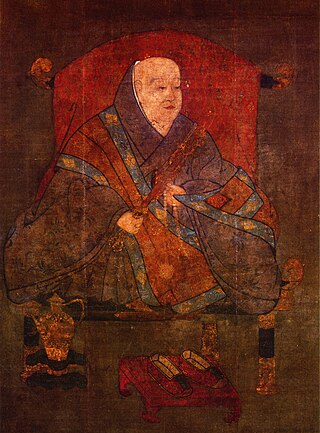
Emperor Uda was the 59th emperor of Japan, according to the traditional order of succession.

Fujiwara no Michinaga was a Japanese statesman. The Fujiwara clan's control over Japan and its politics reached its zenith under his leadership.
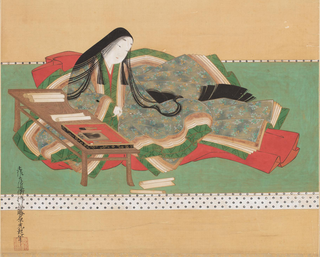
Murasaki Shikibu was a Japanese novelist, poet and lady-in-waiting at the Imperial court in the Heian period. She is best known as the author of The Tale of Genji, widely considered to be one of the world's first novels, written in Japanese between about 1000 and 1012. Murasaki Shikibu is a descriptive name; her personal name is unknown, but she may have been Fujiwara no Kaoriko (藤原香子), who was mentioned in a 1007 court diary as an imperial lady-in-waiting.

The Tale of Genji, also known as Genji Monogatari is a classic work of Japanese literature written in the early 11th century by the noblewoman, poet, and lady-in-waiting Murasaki Shikibu. The original manuscript, created around the peak of the Heian period, no longer exists. It was made in "concertina" or orihon style: several sheets of paper pasted together and folded alternately in one direction then the other.

Minamoto no Yoritomo was the founder and the first shogun of the Kamakura shogunate and of Japan, ruling from 1192 until 1199, also the first shogun in the history of Japan. He was the husband of Hōjō Masako who acted as regent (shikken) after his death.

Hikaru Genji (光源氏) is the protagonist of Murasaki Shikibu's important Heian-era Japanese novel The Tale of Genji. The story describes him as a superbly handsome man and a genius. Genji is the second son of a Japanese emperor, but he is relegated to civilian life for political reasons and lives as an imperial officer.
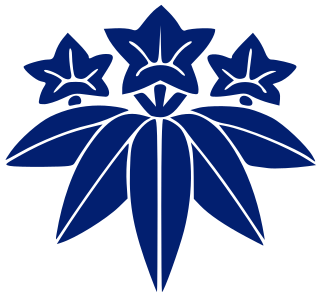
Minamoto (源) was a noble surname bestowed by the Emperors of Japan upon members of the imperial family who were excluded from the line of succession and demoted into the ranks of the nobility since 814. The Minamoto was the most powerful and most important clan of all four great clans that dominated Japanese politics during the Heian, Kamakura, Muromachi and Edo periods in Japanese history—the other three were the Fujiwara, the Taira, and the Tachibana.

The Taira (平) was one of the four most important clans that dominated Japanese politics during the Heian, Kamakura and Muromachi periods of Japanese history – the others being the Minamoto, the Fujiwara, and the Tachibana. The clan is divided into four major groups, named after the emperors they descended from: Kanmu Heishi, Ninmyō Heishi, Montoku Heishi, and Kōkō Heishi.

The Genpei War was a national civil war between the Taira and Minamoto clans during the late Heian period of Japan. It resulted in the downfall of the Taira and the establishment of the Kamakura shogunate under Minamoto no Yoritomo, who appointed himself as Shōgun in 1192, governing Japan as a military dictator from the eastern city of Kamakura.
This is a list of Japanese clans. The old clans (gōzoku) mentioned in the Nihon Shoki and Kojiki lost their political power before the Heian period, during which new aristocracies and families, kuge, emerged in their place. After the Heian period, the samurai warrior clans gradually increased in importance and power until they came to dominate the country after the founding of the first shogunate.

Yabusame (流鏑馬) is a type of mounted archery in traditional Japanese archery. An archer on a running horse shoots three special "turnip-headed" arrows successively at three wooden targets.

Genji (元治) is a Japanese era name after Bunkyū and before Keiō. This period spanned only slightly more than a single year from March 27, 1864 until May 1, 1865. The reigning emperor was Kōmei-tennō (孝明天皇).

The Hatakeyama clan was a Japanese samurai clan. Originally a branch of the Taira clan and descended from Taira no Takamochi, they fell victim to political intrigue in 1205, when Hatakeyama Shigeyasu, first, and his father Shigetada later were killed in battle by Hōjō forces in Kamakura. After 1205 the Hatakeyama came to be descendants of the Ashikaga clan, who were in turn descended from Emperor Seiwa (850–880) and the Seiwa Genji branch of the Minamoto clan.

Minamoto no Yoshiie, also known as Hachimantarō (八幡太郎) and his title Most Valorous Warrior in the Land (天下第一武勇之士), was a Minamoto clan samurai of the late Heian period, and Chinjufu-shōgun.

Sasaki clan are a historical Japanese clan.
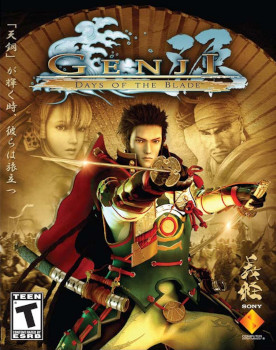
Genji: Days of the Blade, known in Japan as Genji: Kamui Sōran, is an action game that was released for the PlayStation 3, and the sequel to Genji: Dawn of the Samurai.

Sukiyaki Western Django is a 2007 English-language Japanese Western film directed by Takashi Miike. The title of the film refers to the Japanese dish sukiyaki as well as Sergio Corbucci's Spaghetti Western film Django. The film was produced by Sedic International, Geneon Universal Entertainment, Sony Pictures Entertainment, Dentsu, TV Asahi, Shogakukan, A-Team, Nagoya Broadcasting Network and Tokyu Recreation. It also takes inspiration from the "Man with No Name" stock character variously used in the Spaghetti Western genre but most notably in the Dollars trilogy by Sergio Leone. The film features an ensemble cast that includes Hideaki Itō, Kōichi Satō, Yūsuke Iseya, Masanobu Andō, Masato Sakai, Yoji Tanaka, Renji Ishibashi, Sansei Shiomi, Takaaki Ishibashi, Shun Oguri, Quentin Tarantino, Yutaka Matsushige, Yoshino Kimura, Teruyuki Kagawa and Kaori Momoi.

Miyoshi clan is a Japanese family descended from Emperor Seiwa (850–880) and the Minamoto clan (Seiwa-Genji). They were a cadet branch of the Ogasawara clan and the Takeda clan.

Crows Zero, also known as Crows: Episode 0 is a 2007 Japanese action film directed by Takashi Miike with a screenplay by Shōgo Mutō. It is based on the manga Crows by Hiroshi Takahashi and stars Shun Oguri, Kyōsuke Yabe, Meisa Kuroki and Takayuki Yamada. The plot serves as a prequel to the manga and focuses on the power struggle between gang of students at Suzuran All-Boys High School.
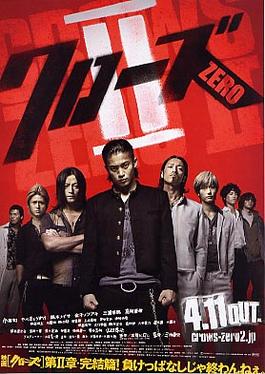
Crows Zero 2 is a 2009 Japanese action film directed by Takashi Miike with a screenplay by Shogo Muto. It is the sequel to Crows Zero, where Shun Oguri, Kyōsuke Yabe, Meisa Kuroki and Takayuki Yamada reprise their roles from the first film.
References
- ↑ "CLOUD OF SPARROWS | Kirkus Reviews". 15 August 2002.
- ↑ "CLOUD OF SPARROWS by Takashi Matsuoka". publishersweekly.com. 12 August 2002. Retrieved 2023-05-24.